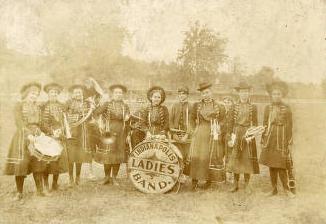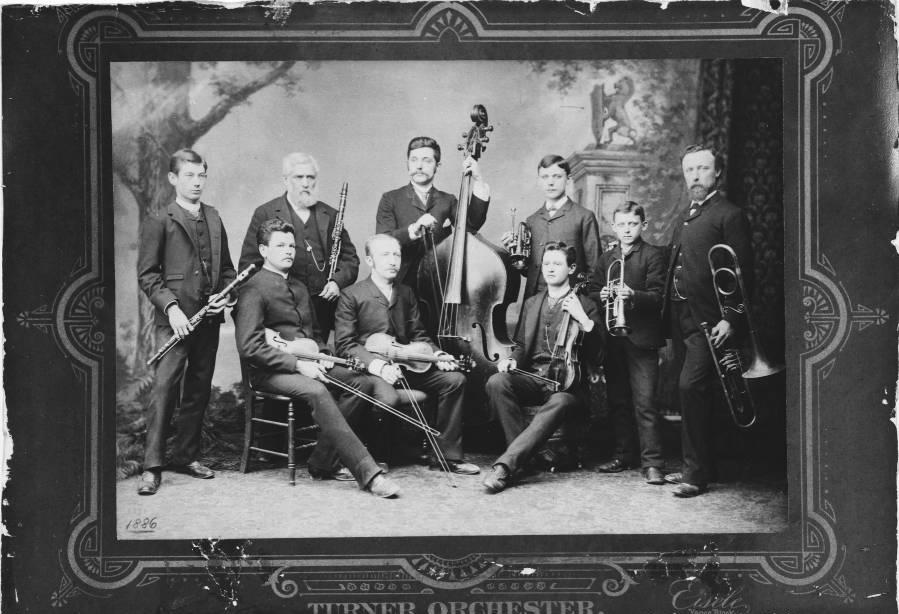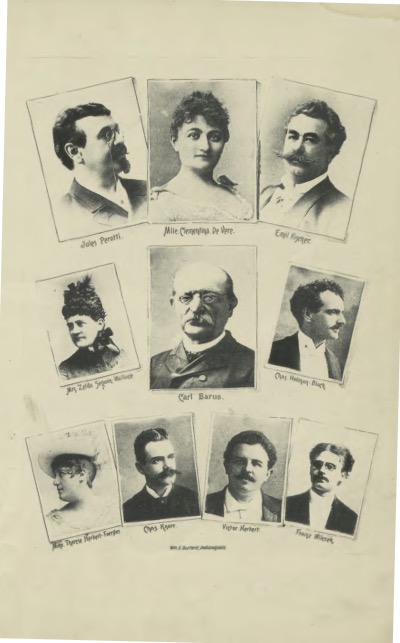Indianapolis residents in the 19th century enjoyed an active and participatory musical life. Music was more than entertainment: it was a shared activity that helped to build community and foster civic pride. Voluntary music associations flourished, as did the serious study of music by ordinary citizens.

The earliest musical activity in the city was the informal singing of hymns and folk songs. The first music organizations were church choirs, including those of the from 1822 and the highly regarded choir of the during the pastorate of . The Society for the Cultivation of Church Music was in existence by 1824.
The first secular music organization was the Indianapolis Handelian Society which performed on July 4, 1828, and included both voices and instruments. The Indianapolis Band was organized in 1840 and is reported to have included many of the city’s leading citizens. Over the next half-century, more than 50 choirs, orchestras, bands, and other ensembles were formed. Some of these grew out of particular ethnic groups, such as the ensembles established by the city’s German Americans and, to a lesser extent, by members of the African American community. These were important vehicles for preserving ethnic heritage. At the same time, the combining of ensembles for festivals and holiday celebrations united the city’s disparate ethnic populations.
One of the city’s most long-lived music organizations was the . Founded in 1854, it remained active until 2018. Also established in the early 1850s was the Handel and Haydn Society, which flourished for two decades or more and which rehearsed Haydn’s oratorio in 1851 with a large chorus and an assortment of available instruments.
During the second half of the century, performances took place in more than two dozen concert halls and typically involved both amateur and professional musicians. Programs were usually made up of many short works or excerpts and included classics of the Western European repertory intermingled with American patriotic music, folk songs, and hymns.
In the 1860s, concerts were offered by numerous ensembles, most prominently the Mendelssohn Society, the Philharmonic Society, and the Philharmonic Orchestra. The Mendelssohn Society was established as a chorus in 1867; an orchestra was added later. The society and its director organized performances for the benefit of the building fund in 1886, including concerts featuring a chorus of 600 girls.
The Philharmonic Society offered weekly concerts. In 1870, the Philharmonic Orchestra consisted of three violins, one double bass, one flute, one clarinet, one horn, and one trombone. The orchestra’s small size did not prevent it from performing works by Beethoven and Wagner. Also active around this time was the Concordia, a short-lived vocal ensemble, not to be confused with a drama society of the same name. Other ensembles included the Druid Maennerchor, Frohsinn, Beethoven Society, and Musicale. The Musicale, unlike the others, reportedly gave private parlor concerts in preference to public performances.
Musical life reached its peak during the 1870s and 1880s when an increasing number of music societies engaged ordinary citizens in semi-weekly rehearsals and regular concerts. The Choral Union was the leading ensemble of the Anglo-American segment of the community. It presented many oratorios, including the city’s first performance of Handel’s in 1874. By 1877, it had over 100 members, including an orchestra. The was the second leading German-American ensemble, after the Maennerchor. The , one of the oldest surviving music clubs in the United States, was established in 1877 to encourage music education and appreciation, performance, and friendship.
In the early 1870s, a small group of German Americans established the Lyra Society for the purposes of study and performance. The group developed into a mixed choir with an orchestra that was generally regarded as the best in the city. It offered frequent performances of Gilbert and Sullivan operettas. Another orchestra was founded at the Academy of Music. The Indianapolis Orchestra, a community group, gave its first performance in 1876 together with the Indianapolis Glee Club.

The Indianapolis Opera presented a full schedule of operettas in the 1880s, in addition to the premiere of the opera by local composer Barclay Walker. It also offered an ambitious production of J. S. Dalrymple’s , a largely forgotten opera that was popular in the second half of the 19th century described as an “original, legendary spectacle.” The Indianapolis production involved costly scenery and machinery that enabled hundreds of children cast as fairies to fly above the stage.
Other community ensembles that flourished during these two decades were the A. B. Clifford String Band, reported to have included two violins, double bass, flute, and cornet; the Cecilian Glee Club, a small but active singing society; the Harmonic Society, a breakaway group from the Choral Union; the Harmonie Society, a German American men’s chorus; the Euterpean Society, named after Euterpe, the Greek Muse of music, in which Mayor Daniel McCauley played the flute; the Harugi Maennerchor; the Indianapolis Chorus; the When Band, an ensemble sponsored by the ; the Socialisticher Saengerbund, and other choirs, orchestras, and bands. “Literary concerts” were popular among the city’s African American residents. These featured both solo and ensemble singing and dramatic recitations, often on biblical subjects.
In 1895 the German-born teacher and conductor Karl Schneider organized the Indianapolis Symphony Orchestra, an ensemble unrelated to the orchestra founded in 1930. Two years later, the Musikverein was formed as part of the German House. It included a men’s choir, mixed choir, and 60-piece orchestra.
Music festivals were an important part of the city’s civic life. A large number of music teachers’ conventions, festivals of the German singing societies, African American music festivals, and spring festivals featuring huge choruses brought together musicians and families from many different church and community ensembles.

Although music making was to a large extent an amateur activity, as many as 131 professional musicians and music teachers may have been working in the city by 1880. Prominent among them were ; James S. Black, who conducted the Choral Union; Thomas N. Caulfleld, who conducted the Mendelssohn Society; William Horatio Clarke, an organ builder who directed the Harmonic Society; Alexander Ernestinoff, who conducted the Maennerchor, Liederkranz, and Lyra; Max Leckner, a pianist who also directed the Maennerchor, Philharmonic Society, and Cecilian Glee Club; organist Peter Robuck Pearsall; tenor Ora Pearson, who organized the Indianapolis Orchestra and Indianapolis Opera; Hubert J. Schonacker, a pianist, organist, and composer; and Emil Wulschner, conductor of the Lyra and Choral Union orchestras and owner of the state’s largest music store.
Guest artists frequently traveled to Indianapolis and surrounding towns. Norwegian virtuoso violinist Ole Bull gave a recital in Indianapolis in 1853 together with Czech-born pianist and impresario Maurice Strakosch and 10-year-old Italian opera singer Adelina Patti. In 1859, Cooper’s English Opera Troupe staged the city’s first full opera production. Before 1867, one of the most distinguished virtuoso pianists of the 19th century, Sigismond Thalberg, Belgian composer and violinist Henri Vieuxtemps, and American composer and pianist Louis Moreau Gottschalk had all performed in Indianapolis.
Russian pianist, composer, and conductor Anton Rubinstein and Polish violinist and composer Henryk Wieniawski presented a recital in Indianapolis in 1872, and German conductor, virtuoso pianist, and composer Hans von Buelow gave recitals in 1876. German operatic soprano Lilli Lehmann was the soloist with a festival chorus in 1886. The Theodore Thomas Orchestra, which began touring the U.S. in 1869 and was led by Theodore Thomas who served as an early conductor of the New York Philharmonic and the Chicago Symphony Orchestra, was a frequent visitor.
Many other traveling opera troupes also introduced Indianapolis audiences to favorites from the German, Italian, and French repertories. Soloists with May festivals in the 1890s included Nellie Melba, one of the most famous singers of the late-Victorian era, Eugène Ysaÿe, Belgian virtuoso violinist, and Edward MacDowell, American pianist and composer.
Local, national, and international music activity was followed in a number of local publications, including Benham’s Musical Review, which was connected with Benham’s music store, owned by Henry L. Benham a purveyor of organs and band instruments located at 36 E. Washington Street. It appeared originally as the Western Musical Review in 1866. Music lovers could also read about musical developments in Willard’s Musical Visitor, established in 1870 by Albert G. and Albert B. Willard who sold pianos, organs, sheet music, and other musical merchandise out of their store, and in reviews and essays by and others.

Help improve this entry
Contribute information, offer corrections, suggest images.
You can also recommend new entries related to this topic.